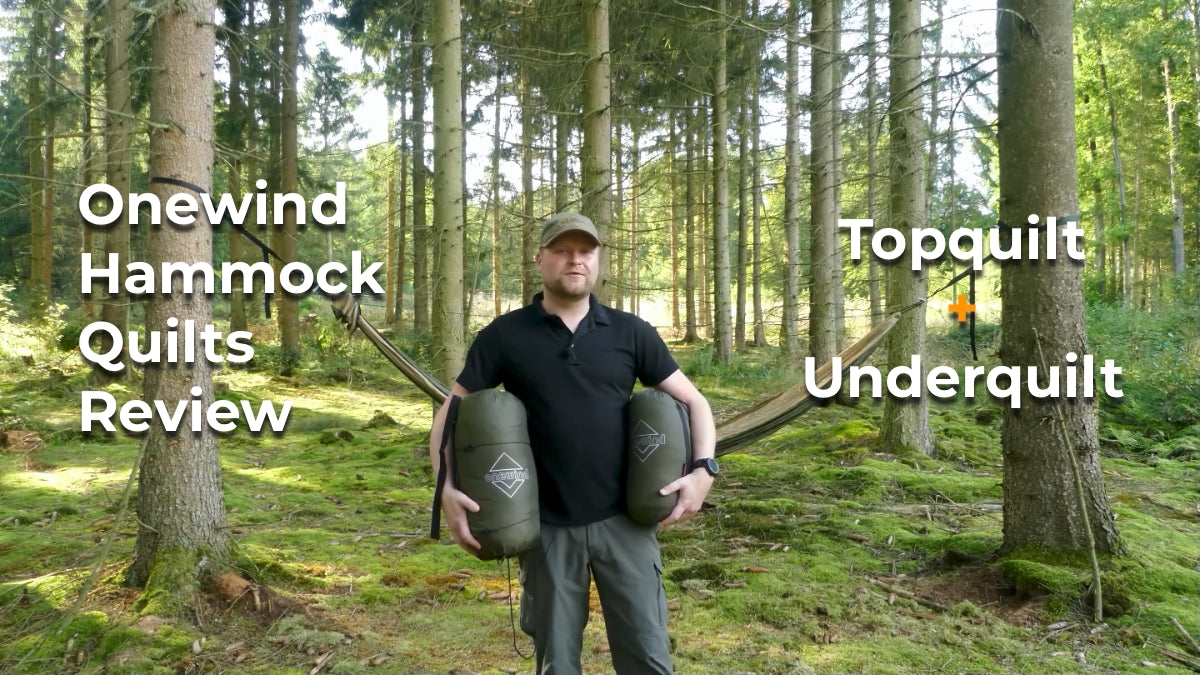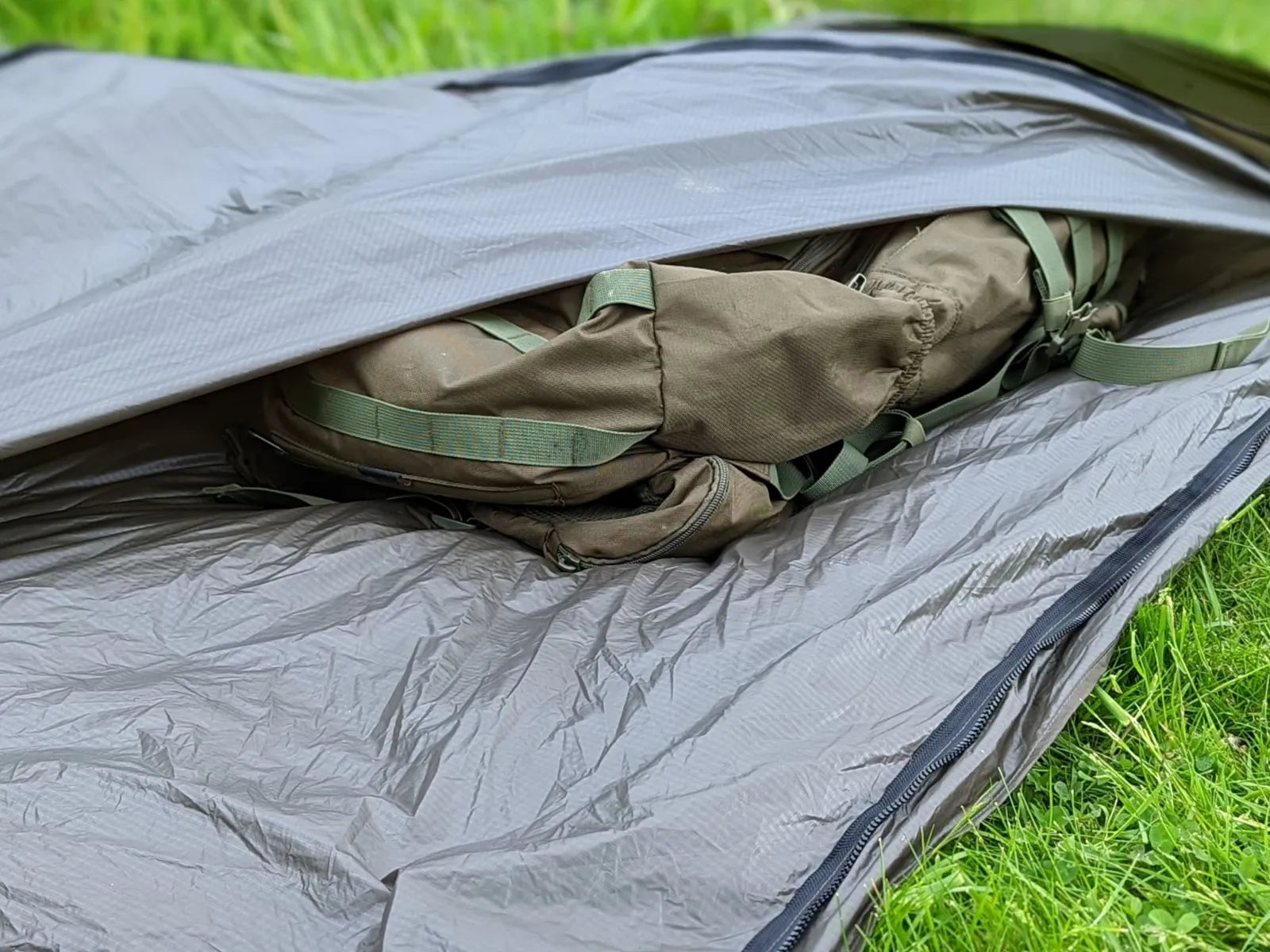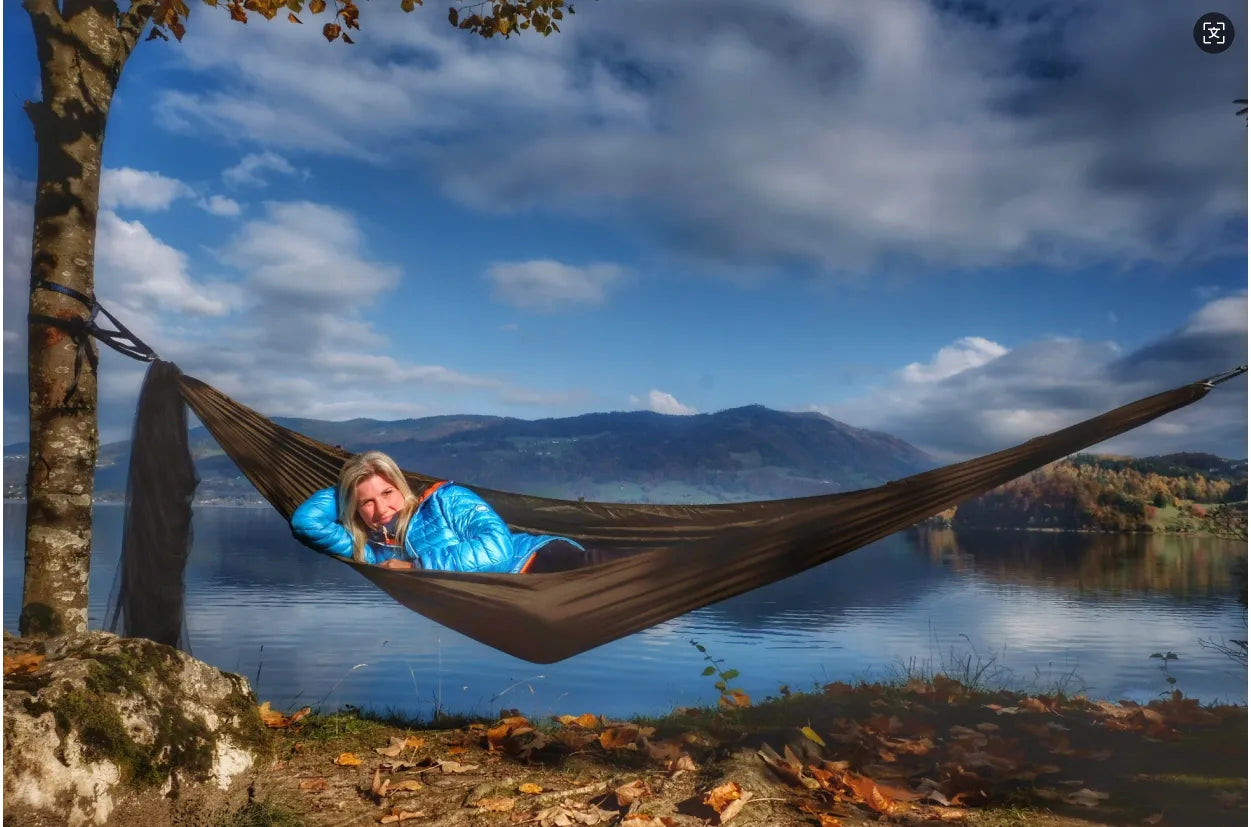The two quilts are a modular 4 seasons underquilt and a top quilt that can be used as a poncho liner. The quilts are each delivered in a compression bag.

And that's where I come to the biggest point of criticism: The compression bags do not have two straps that cross each other, as is usually the case, but only a single strap. On the one hand, it is more difficult to compress with just one strap and, on the other hand, this strap sometimes slips down. The problem with underquilt has been improved a bit by using two cords that can be stretched through line locomotives. I recommend replacing the compression bags. Onewind offers compression bags made of Silnylon with two straps. They should work better.
The poncho top quilt
I have the thicker lined version in size L, which is supposed to insulate up to about 0 degrees. There is also a lighter, less thickly lined version.

The basic shape is a rectangular ceiling. There is a noticeable slit almost in the middle, which is closed with snaps. The head is put through this because you can wear the quilt like a poncho liner. Similar to the Helikon-Tex Swagman. But the Onewind Poncho Quilt is designed differently. It does not have a circumferential zipper, but snaps with which you can button a foot box. At the end of the foot box, there is a cord that runs through a sewn canal. With this cord and two cord stoppers, you can close the foot box. There is a buckle on a strap above so that the press studs on the foot box do not accidentally open. If you use the quilt as a poncho, you can tie the poncho around your stomach with this strap.

At the head end of the quilt, there is still a push button so that you can close the quilt behind the neck. Here I would have found it nice if you could gather the head end with a cord and cord stopper. This is particularly important at low temperatures.
Low temperatures? Yes, because the version I'm showing here should work up to just over 0 degrees. I haven't been able to try that yet because it hasn't been that cold before. But I'll catch up on that and then write my review about the quilts.
For the insulating filling, Onewind relies on a synthetic fiber made from corn. This synthetic fiber is called Sorona and is manufactured by DuPont. By using renewable, plant-based components, this insulation material is more environmentally friendly than other insulation materials made from plastic fibers.
Here are the technical data of the poncho top quilt:
- Size: 220x140cm (manufacturer information)
- Pack size uncompressed: approx 36x19cm (measured by yourself)
- Weight: 1075 grams (reweighed)
- Temperature range: up to approx. 0 degrees (manufacturer information)
- Outer material: Wind and water repellent 38g / m² nylon
- Filling: DuPont Sorona
The modular underquilt
A modular underquilt? Yes, because the underquilt consists of two parts: the underquilt itself and a blanket that can be buttoned into the underquilt using press studs. I think this idea is great because it gives you a 4-season underquilt and a blanket for the summer. The blanket can be buttoned together to make a quilt. Brilliant! But: there is no way to close the foot box. That's a shame because it would make the system perfect.

I have tested the underquilt in connection with the blanket as a top quilt and can say that the comfort limit is around 10 degrees. However, I have to say that I hung in the wind during the test. On windless nights you can use the quilt combination at lower temperatures. But everyone has to find out for themselves because everyone has a different temperature perception.
If you button the blanket into the underquilt, you increase the insulation performance considerably. Here, too, Onewind relies on DuPont Sorona is the insulation material and specifies a temperature range between 0 and -9 degrees. I haven't been able to test that yet, but I'll do it again and then write my review of the quilts.
We come to the hanging of the underquilt. The packsack has two openings, a carabiners hangs out of one. You hook this into the suspension of your hammock, open the other end of the packsack and pull the underquilt out when you go to the other end of the hammock. This ensures that the underquilt cannot accidentally fall onto the (wet) floor.
Three cords run from the carabiner to the underquilt. One each to the corners and one in the middle. The cord in the middle ends in a line locomotive, which in turn is attached to the quilt with a rubber cord. There are also line locomotives at the corners. These three points can be used to adjust the length of the cords and thus adapt the underquilt to the hammock. This suspension design was new to me and I think it is very well made. You can adjust the underquilt well. A little tip: When you have finished setting the underquilt, you should tie a knot at the end of the cord that hangs out of the line locomotive. Otherwise, the suspension may be misaligned when you repack the quilt.
The two ends of the underquilt can be closed on the hammock with an elastic cord and cord stopper.

The side of the underquilt is held by a rubber cord. There are also two D-rings on each side towards the head and foot ends. You can attach the supplied cords to it, which are then attached to the ridgeline of the hammock. These cords can then be adjusted with line locomotives. This helps to adjust the underquilt so that it also lies against the back and legs.

The variety of setting options can overwhelm a layperson. Therefore Onewind provides illustrated assembly instructions. I give them great praise for this because you won't find anything like that even with very high-priced manufacturers.
How to adjust the underquilt can also be seen in my video for the two quilts. The video is embedded at the end of this article.
Here are the technical data of the modular underquilt:
- Size: about 208x132cm (there is also a smaller version that is about 168x120cm)
- Pack size uncompressed: approx 45x22cm (measured by yourself)
- Weight: 1975 grams (reweighed)
- Temperature range: 0 to -9 degrees (with buttoned cover. Manufacturer information)
- Outer material: Wind and water repellent 38g / m² nylon
- Filling: DuPont Sorona
Conclusion
The two quilts each have interesting features that have never been seen before on the market. The processing quality is on a high level, there is nothing to complain about. The materials used also appear high-quality and robust. The prices for the quilts are reasonable and can be described as cheap for what you get. As already mentioned, there is only room for improvement in the details.
Who are the quilts for? Due to the weight and pack size, certainly not for the hiker who walks many kilometers a day. The quilts are aimed more at bushcraft workers and campers who do not cover long distances with their equipment.
I will include the two quilts in a long-term test and will probably write a review with my final conclusion at the beginning of next year.
You can get the two quilts on Amazon: Onewind Poncho Quilt * and Onewind modular underquilt *
Or in the Onewind Shop: Onewind Poncho Quilt and Onewind modular underquilt
In the Onewind Shop, you get a 10% discount via this link and another 5% with the code DENNISGEHTRAUS: https://www.onewindoutdoors.com/?ref=zhtybsainn
* The links listed are so-called affiliate links. As an Amazon partner, I earn from qualified sales.
Here is my video about the Onewind quilts:
And that's where I come to the biggest point of criticism: The compression bags do not have two straps that cross each other, as is usually the case, but only a single strap. On the one hand, it is more difficult to compress with just one strap and, on the other hand, this strap sometimes slips down. The problem with underquilt has been improved a bit by using two cords that can be stretched through line locomotives. I recommend replacing the compression bags. Onewind offers compression bags made of Silnylon with two straps. They should work better.
From: Dennis under Outdoor Equipment
This article was originally published in German in Denis geht raus and translated in English.




